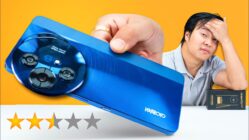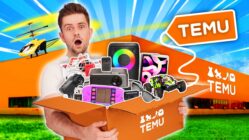Scrolling through the internet, I stumbled upon the Nokia G42, the last Nokia phone, being sold. Naturally, I had to buy it and see what’s inside the box. The phone comes in a box that mentions 6GB RAM. Sliding it open, I was immediately struck by the phone’s color – Nokia has done a great job with it. Inside, we find a SIM ejector tool, a case that feels just okay, some documentation, and a very portable charger. The cable is Type-A to C.
Now, let’s talk about the phone itself. The design is really appealing, with a unique red color that the frame complements nicely. I’ve tested the phone thoroughly, and it turns out Nokia has a really interesting story to tell, which I’m going to share with you all today. My name is Sanchit, and this is TechBar. If you like this kind of content, hit that subscribe button and the bell icon.
Nokia’s Journey: From Iconic to Almost Forgotten
Nokia’s history in the tech world is quite something. We all remember Nokia as an iconic brand, the one everyone bought. And now, I have their last smartphone launched under HMD Global. To understand this, we need to look at HMD. Founded in 2016 by former Nokia officials, HMD aimed to bring Nokia back, especially after Microsoft’s Lumia phones, which ran on Windows Phone, failed to gain traction and are now considered a major flop.
Key Takeaways
- Nokia’s smartphone comeback under HMD Global faced significant challenges.
- Poor spec-to-price ratio was a major issue, especially in the Indian market.
- Strong competition from Chinese brands like Xiaomi, OnePlus, Oppo, and Vivo.
- Misplaced focus on unique selling points (USPs) like repairability without proper marketing.
- Questionable innovation, like the five-camera Nokia 9 PureView, which suffered from performance issues.
- An identity crisis, as Nokia was known for durability, not cutting-edge tech.
- HMD has stopped launching phones under the Nokia brand, focusing on its own lines.
- There’s a possibility of Nokia returning to the smartphone market through collaborations.
The Nokia G42: A Case Study in Missed Opportunities
The Nokia G42, launched in 2023, is a prime example of where HMD went wrong. It’s quite surprising to find an FM radio app on a 2023 phone, but the display is where things really fall apart. With large bezels and a dual-drop notch, the bottom bezel is particularly noticeable. It sports a 720p LCD panel with a 90Hz refresh rate. For a phone priced around ₹12,000, these display specs are quite disappointing.
But it’s not just the display. In India, processors are a big deal. Nokia opted for the Snapdragon 480 Plus, a chipset that was already two years old in 2023, having launched in 2021. An N2 benchmark score of around 400,000 indicates that even if someone buys this phone for the Nokia brand name, it will likely struggle within two years as apps demand more performance. This was a significant compromise in performance.
On the software front, HMD did a decent job. The phone runs stock Android, and Nokia promised two years of updates. Currently, it’s running Android 15, so the update policy was met. However, other aspects like the battery and camera were also underwhelming for the price. Simply put, the phone lacked anything special and couldn’t compete effectively.
Nokia’s Downfall: Four Key Reasons
This wasn’t the only phone with a poor price-to-performance ratio; many Nokia phones launched in India suffered from this. Nokia never seemed to grasp that India is a spec-heavy market where processors are taken very seriously. Despite pricing phones between ₹40,000-₹50,000, they never offered a good processor.
Beyond the price-to-performance issue, several other factors contributed to Nokia’s struggles:
- Chinese Competition: By 2016, Chinese brands had taken over the Indian smartphone market. Xiaomi was extremely popular for offering great specs at low prices, while OnePlus was known for its “flagship killer” phones. Oppo and Vivo dominated the offline market with extensive advertising. Amidst this intense competition, Nokia failed to stand out because it wasn’t offering anything extraordinary.
- Wrong Unique Selling Proposition (USP): Nokia phones were repair-friendly, but this feature was never effectively marketed. While the G42 is considered repair-friendly, a quick call to a Nokia service center revealed that a screen repair would cost around ₹2,700-₹2,800 and could be done in 15-20 minutes with parts readily available. This is impressive service, but when compared to brands offering better specs at similar prices, the repairability USP alone wasn’t enough to sway consumers.
- Wrong Innovation: It wasn’t just about specs. Nokia’s focus on innovation was sometimes misplaced. The Nokia 9 PureView, launched in 2019, featured five cameras (two RGB, three monochrome), all 12MP with the same focal length. Nokia claimed this would provide better colors and black-and-white photos. However, the reality was that the phone lagged significantly when capturing photos and lacked Optical Image Stabilization (OIS), which was crucial in 2019. Spending ₹50,000 on such an unstable experience was not ideal.
- Identity Crisis: HMD aimed to leverage Nokia’s legacy as an iconic brand. While Nokia is a huge name, its core identity has always been durability, exemplified by the legendary Nokia 3310. People remember Nokia for its toughness, not for being at the forefront of technology. This lack of an identity as a cutting-edge tech provider has hindered its smartphone success since 2016, despite selling feature phones.
The Future of Nokia Phones
It’s clear that HMD hasn’t been on the right track with Nokia smartphones. As of mid-2025, HMD has stopped launching smartphones under the Nokia brand, opting for its own lines like HMD Skyline. These new phones also aren’t particularly innovative or spec-heavy.
However, there’s a glimmer of hope. A post on Reddit, later deleted, indicated that a Nokia manager confirmed the company is looking for collaborators to build phones again. While we can’t be sure if Nokia will return, I personally hope it does. The nostalgia associated with Nokia is immense, and we’ve seen how well Motorola has been received upon its comeback. If Nokia can execute properly, it could gain similar affection.
My question to you is: If Nokia returns with the right specifications and products, would you buy it? Let me know in the comments. If you enjoyed this video, please like it and join the TechBar Army by subscribing. We believe in quality. See you in the next video. Thanks for watching!






